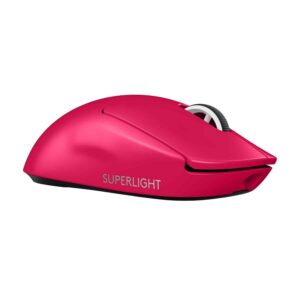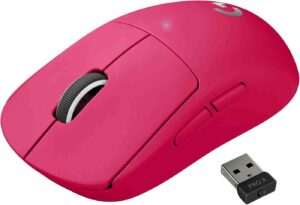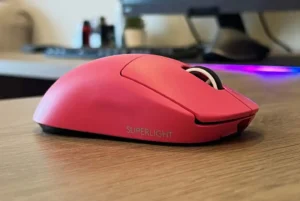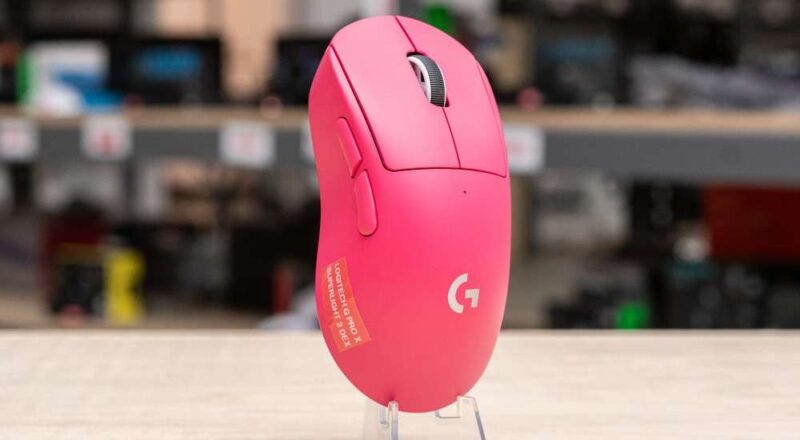Are the improvements promised by the Logitech G PRO X Superlight 2 worth the additional money? To aid with your decision-making, here is a breakdown.
Gaming mice have advanced significantly, and Logitech offers one of the strongest product lines available. I’ve used a range of their equipment, and the most of them are excellent in terms of quality. Even when a couple weren’t flawless, their customer service was quick to respond and occasionally even supplied a replacement without that the old one be returned. To be honest, I can’t think of many brands that are as reliable as Logitech.

The Logitech G PRO X Superlight, their lightest mouse to date, was released in 2020. With the subsequent iteration, the Logitech G PRO X Superlight 2, they further reduced weight. However, if you’ve played games for any length of time, you know that a lighter mouse won’t solve every problem. There isn’t a single solution that works for all game genres.
It might be time to treat yourself to a mouse that feels fantastic, responds quickly, and provides you greater control if you frequently play PC games. What is the difference between the two Superlight versions, and is it worth the money? Let’s dissect it.
Design Comparison of the Logitech G PRO X Superlight 1 and 2
Does your gaming mouse’s design actually matter that much? Sort of. as it won’t improve your aim, it will keep you relaxed and steady as you play.
Design is important in games like Overwatch; it’s not simply a bonus. A mouse that weighs less than 3.5 ounces, tracks well, and feels comfortable in your palm can help you maintain aim without causing you to struggle with your equipment.

Most people wouldn’t notice anything at first look if the Superlight 2 were placed next to the original. Although the form is mostly unchanged, there are a few minor adjustments that are worth mentioning.
Read Also : The Top Tech Device Gifts for Men and Women: A Guide for Friends and Employees
Weight
After hours of quick mouse swipes and constant clicking, gaming—whether you’re an expert or simply played for fun—takes a toll on your wrist. I’ve found that hefty mice quickly tire you out since I spend much too much time using them. That can affect your aim and response time, particularly if you’re a shooter.
As it happens, there is some science underlying it. In one study, mice weighing less than 3.5 ounces performed better for top-level first-person shooters. They maintained a precise aim and locked on to targets more quickly. I was shocked to see the effect of even a 0.2-ounce change. Gamers quickly realized this, and it was evident in their gameplay.
Consider the G PRO X Superlight from Logitech. Although it weighs 2.2 ounces, the second-generation model reduces that weight even further to 2.12 ounces. When I play with low sensitivity, I prefer to use the lightest mouse available. After a time, heavier ones simply make my wrist feel slower. However, if I’m playing a story-driven RPG (like Deus Ex), I’ll choose a chunkier mouse since it feels more stable and gives me more control.
Comfort
A mouse’s feel in your palm has the power to make or ruin your experience. The ideal mouse for you might not be suitable for someone else because everyone has various hand sizes and grip preferences. These Logitech versions are rather small and manageable, measuring 4.92 inches in length, 2.5 inches in width, and 1.57 inches in height.
The Logitech G PRO X Superlight 2 has a louder click than others, according to several Amazon users. However, it is incredibly fulfilling rather than bothersome. When playing high-stakes games, those clicks seem powerful and precise, which is quite helpful. Even if you spend hours riveted to your screen, its form will feel comfortable in your palm. The entire item seems solid and well-made, even if it is lightweight.
The first-generation model’s design resembles a hug for your hand. It’s easy to forget you’re holding it because of its smooth, egg-like curvature. This is a significant improvement from the strangely shaped mouse that some people had been using, which caused their pinky to hurt after extended gaming sessions.
With the Logitech G PRO X Superlight 1, you may comfortably utilize your fingertips, rest your entire palm, or employ a claw grip. Switching grip techniques is also said to be straightforward.
Read Also : Developing More Intelligent AI Conversations: using Siri to Socrates
Control in the Logitech G PRO X Superlight 1 and 2
Although I like having more settings at my fingertips, I often just use the most basic ones. Nonetheless, a good gaming mouse need to fulfill a few requirements. Having two buttons near the thumb and maybe one or two up top, including the scroll wheel click, is helpful in addition to the normal left and right clicks. It works as long as the average hand can easily reach them.
The initial generation There are five buttons on the Logitech G PRO X Superlight: two side buttons, a left and right button, and a scroll button. The Logitech G HUB software allows you to configure each of them. Even changing profiles on the fly is possible with a single press. A second set of controls can also be accessed by assigning a G-Shift input.

The PRO X Superlight 2 allows you to remap all five buttons, including the primary clicks. You may double your selections by designating one of them as a G-Shift button. Instead of the mechanical switches used in the original generation, this model makes use of LIGHTFORCE hybrid optical switches. You can click faster and avoid double-clicking if you put it on optical mode. However, the battery usage is higher.
The buttons on certain mouse seem too rigid. Just to register a click, I’ve had to struggle with them. Resistance like that slows down progress and makes simple activities into a hassle.
In contrast, the Superlight takes the other path. Its buttons have always been more responsive and gentler. Because it may make short touches feel snappier, especially during fast-paced action, many individuals like that lighter touch.
For my part, I want a little more resistance—something in between soft and stiff. I get what Logitech was trying to do, though. It reminds me of the buttons on gaming controllers, which are made to be quick without disrupting your rhythm.

[…] Read Also : What is your preferred wireless gaming mouse between the Logitech G PRO X Superlight 2 and 1? […]
[…] Also Read : What is your preferred wireless gaming mouse between the Logitech G PRO X Superlight 2 and 1? […]